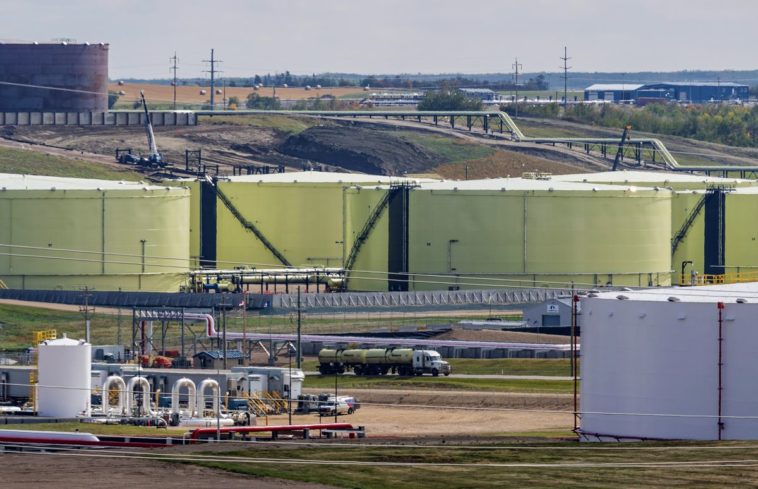Monday’s analyst upgrades and downgrades
/cloudfront-us-east-1.images.arcpublishing.com/tgam/C6CQASGY6BDGPFA6T22SRVDA4Y.jpg)
Inside the Market’s roundup of some of today’s key analyst actions
A group of equity analysts on the Street raised their target prices for shares of Laurentian Bank of Canada (LB-T) in response to better-than-anticipated fourth-quarter results.
Before the bell on Friday, Laurentian reported cash earnings per share of 91 cents, exceeding the consensus expectation of 73 cents.
“It is worth noting that this metric has bounced around a lot over the past few years as the bank worked through various iterations of restructuring initiatives, and the gap between reported and cash remains wide,” said Desjardins Securities analyst Doug Young. “What drove the beat? A few items—stronger capital markets results, net gain on the securitization of a mortgage portfolio and lower noninterest expenses (NIX).”
Mr. Young raised his target to $33 from $31 with a “hold” rating. The current average on the Street is $31.40, according to Refinitiv data.
“We were encouraged by the remarks made by Rania Llewellyn, LB’s new CEO,” he said. “However, this bank has gone through many iterations of restructuring over the years, and we’ll have to wait for more colour on what’s next in this journey.”
“We remain cautious on the name. We are interested to hear more on the new CEO’s strategy.”
Others increasing their targets included:
* Scotia Capital’s Meny Grauman to $33 from $30 with a “sector perform” rating.
* Credit Suisse’s Mike Rizvanovic to $30 from $28 with an “underperform”
* CIBC’s Paul Holden to $32 from $30 with an “underperformer”
* TD Securities’ Mario Mendonca to $35 from $32 with a “hold” rating.
=====
Analysts also applauded better-than-expected fourth-quarter results from Canadian Western Bank (CWB-T).
Desjardins Securities’ Doug Young raised his target to $35 from $31, keeping a “buy” rating. The average is currently $32.73.
Others making changes included:
* RBC Dominion Securities’ Darko Mihelic to $32 from $28 with a “sector perform” rating.
* CIBC’s Paul Holden to $34 from $33 with a “neutral” recommendation.
* TD Securities’ Mario Mendonca to $34 from $33 with a “buy” rating.
=====
CIBC World Markets analyst Kevin Chiang made a series of target price changes to stocks in his coverage universe on Monday.
His changes included:
Linamar Corp. (LNR-T, “outperformer”) to $73 from $71. The average is $62.33.
Magna International Inc. (MGA-N/MG-T, “outperformer”) to US$75 from US$68. Average: US$68.08.
Martinrea International Inc. (MRE-T, “outperformer”) to $20 from $16.50. Average: $18.38.
NFI Group Inc. (NFI-T, “outperformer”) to $25 from $21. Average: $21.71.
Parkland Corp. (PKI-T, “outperformer”) rose to $51 from $49. Average: $47.38.
GFL Environmental Inc. (GFL-T, “outperformer”) to $42 from $32. Average: $32.35.
TFI International Inc. (TFII-T, “neutral”) to $78 from $70. Average: $76.44
Transat AT Inc. (TRZ-T, “neutral”) to $7 from $5. Average: $4.88.
Bombardier Inc. (BBD.B-T, “neutral”) to 50 cents from 40 cents. Average: 45 cents.
Air Canada (AC-T, “outperformer”) to $32 from $25. Average: $26.22.
Chorus Aviation Inc. (CHR-T, “outperformer”) to $5.50 from $5. Average: $4.81.
Canadian Pacific Railway Ltd. (CP-T, “outperformer”) to $490 from $444. Average: $454.13.
Canadian National Railway Co. (CNR-T, “neutral”) to $153 from $141. Average: $129.56.
=====
Seeing it as “a low-risk investment vehicle for exposure to an attractive dividend, with ample dry powder for continued growth, Desjardins Securities analyst Justin Bouchard initiated coverage of Topaz Energy Corp. (TPZ-T) with a “buy” recommendation.
“The investing public has no shortage of options both within and outside of the energy space,” he said. “When presented with this veritable smorgasbord of opportunities, the question is why invest in TPZ? The answer comes down to TPZ’s unique business model which, to the best of our knowledge, has no directly comparable analogue, at least not in North America.
“Whether by intent or happenstance, the TPZ business model appears to borrow a page from fields such as animal husbandry and horticulture where, through a process of selective breeding, the ideal is to create a hybrid that combines the desired characteristics of two different parents. Applying that analogy to TPZ, an argument can be made that its unique cash flow profile is a hybridization resulting from the pairing of an upstream E&P royalty business with an energy infrastructure model. Broadly speaking, E&P royalty cash flow is characterized by volume and commodity exposure but is unburdened by the underlying costs related to production and asset maintenance. Meanwhile, the typical energy infrastructure business follows a tolling model — a fixed fee is generally paid on volumes handled; the variability of throughput may vary depending on a host of factors (such as the existence of take-or-pay provisions), but the cash flow profile is, by and large, characterized by comparative stability.”
Mr. Bouchard set a $20 target for Topaz shares, which began trading on the TSX in late October. The average is $17.30.
“In practical terms, what TPZ offers prospective investors is the best of both worlds with respect to cash flow characteristics (and thereby implied market valuation). Indeed, the asset bases are complementary — the upstream royalties provide the opportunity for commodity price and volume upside with minimal cost exposure while simultaneously compensating for the inherently limited upside of the midstream business model. Meanwhile, the midstream business — comprised primarily of long-term take-or-pay cash flows backed by high-quality counterparties—provides a base of stable, ratable cash flow. The key point is that the hybrid TPZ model provides a floor for earnings — thereby protecting the dividend in a downside commodity price environment — and leverage to commodity prices (mostly natural gas pricing). To put it simply, each cash flow stream has its set of benefits and drawbacks. And, as we see it, there are two key, interrelated criteria that govern the extent to which these benefits and drawbacks manifest —namely, counterparty quality and commodity prices.”
=====
Industrial Alliance Securities analyst Elias Foscolos thinks there’s “something for everyone” in the utilities sector, which has been “relatively insulated” from the impact of the COVID-19 pandemic.
“Some key reasons that regulated utilities have been so resilient to the pandemic overall are 1) utilities are essential service providers, 2) increased residential sales due to isolating and work-from-home/school-from-home measures have provided an offset to lower commercial and industrial sales, 3) residential sales are generally higher margin than commercial or industrial sales, and 4) the regulated return structure mitigates load reduction through decoupling, formulaic rates, and cost recovery,” he said.
“Despite these factors that mitigate direct negative impacts to financial performance, our analysis indicates that COVID-19 has affected our coverage universe in other ways. COVID-19 has damaged the Alberta economy, lowering CU’s near-term CAPEX profile. We could potentially see a regulatory offset whereby a weaker outlook for Alberta is compensated for by a more favourable regulatory compact when new rates are determined. In our view, FTS has also experienced a direct negative impact due to delayed rate case proceedings at TEP. We believe EMA has essentially been unaffected, while H has likely experienced a modest tailwind from changes in the load mix.”
Though he said those factors represent risks to the sector, Mr. Foscolos thinks policies that increase “rate-recoverable spending on resiliency and decarbonisation will likely strengthen the organic growth profile for utilities.”
After adjusting his valuation methodology include a dividend discount model (DDM), Mr. Foscolos raised his target for all four utilities in his coverage universe:
Calling it the “valuation play,” he increased his Canadian Utilities Ltd. (CU-T, “buy”) target to $37 from $36, which is the current average on the Street.
“CU’s strong balance sheet and discounted value relative to comparables are reflected in higher valuations through EV/EBITDA and P/E multiples,” he said. “This ultimately reflects our thesis on the stock, which we ee as an underleveraged but low-growth valuation play. We believe deployment capital into regulated investments outside of Alberta would likely be accretive and welcomed by investors. CU has lowered its ESG risk through the divesture of its Alberta- based fossil fuel generation assets in 2019, and maintains only a small amount of exposure to natural gas generation.”
Mr. Foscolos called Hydro One Ltd. (H-T, “hold”) “the safe play” and raised his target to $31 from $30. Average: $30.79.
“H maintains ultra-conservative leverage and payout ratios, as well as respectable secured rates through 2022,” he said. “The Company’s revenues are 99-per-cent regulated and are earned in one jurisdiction, Ontario, which we believe will experience stable, long-term economic growth. As such, we view the stock as the safest pick in the sector. We believe H’s quality, among other tailwinds including weather, has driven outperformance of the stock year-to-date amidst a flight to safety.”
Seeing them as “growth stories,” he also increased his targets for:
- Emera Inc. (EMA-T, “buy”) to $63 from $60. Average: $61.33.
- Fortis Inc. (FTS-T, “buy”) to $60 from $58. Average: $59.43.
=====
Separately, in his weekly note reviewing the week for pipelines, utilities, midstream and fuel distribution companies, Mr. Foscolos lowered his rating for Gibson Energy Inc. (GEI-T) in reaction to “strong” price appreciation.
He moved the Calgary-based company’s stock to “hold” from “buy” with a $24 target (unchanged). The average on the Street is $24.79.
On the midstream segment, Mr. Foscolos said: “This sector performed very well relative to the TSX with GEI leading the pack. ALA was the outlier posting a negative return last week, but the stock remains the best performing Midstream stock year-to-date matching our Utilities segment’s returns.”
=====
Crescent Point Energy Corp.’s (CPG-T) “disciplined” capital program should allow it to maintain relatively flat production while continuing to gradually trim its debt level, said Desjardins Securities analyst Chris MacCulloch in response to Friday’s release of its budget and guidance for 2021.
“We were most impressed by further progress in reducing operating costs, which resulted in relatively flat estimate revisions, despite lower volumes reflecting the more disciplined capex program,” he said.
“Stay lean and live to fight another day. We have been loudly advocating this mantra for the oil-weighted Canadian producers, particularly those carrying elevated debt levels. Unfortunately, that list includes CPG, by no fault of the current board and management team, which inherited a more aggressive business model built for another era. On that note, it is refreshing to see a company adopting our soapbox advice by living within its means, with a view to taking stronger oil prices as they come (and prudently applying any potential windfall to the balance sheet), rather than relying on sustained US$45–50 per barrel WTI next year. Even more encouragingly, management has adopted this austere tone despite the steady uptrend in oil prices (and equity valuations) since the first Pfizer and BioNTech COVID-19 vaccine announcement on November 9.”
Maintaining a “hold” rating for Crescent Point shares, Mr. MacCulloch raised his target to $3 from $2.50. The average is $2.85.
“By delivering more consistent operational performance and improved capital efficiencies, as once again evidenced by further cost reductions, CPG has better positioned itself to compete for investor mindshare when the eventual recovery in global oil prices occurs,” he said. “By our reckoning, that recovery will likely be more of a 2022 event following mass vaccinations, the correction of global inventories and the normalization of OPEC+ spare capacity. Meanwhile, CPG still has considerable work ahead of it in continuing to right-size the balance sheet, with 2021 strip D/CF tracking near 3.0 times. We expect CPG to remain active on the M&A front as the North American oil & gas industry consolidates, which could present opportunities to accelerate balance sheet deleveraging.”
Other analyst raising their targets included:
TD’s Juan Jarrah to $3.50 from $3.25 with a “buy” rating.
Canaccord Genuity’s Anthony Petrucci to $2.75 from $2.25 with a “hold” rating.
CIBC’s David Popowich to $2.75 from $2.50 with a “neutral” rating.
National Bank’s Travis Wood to $3.75 from $2.50 with an “outperform” rating.
=====
RBC Dominion Securities analyst Walter Spracklin expects the recent sector rotation for North American waste management companies to “persist” in 2021.
“The overall waste sector has modestly underperformed the S&P 500 thus far in Q4; while within the sector GFL has seen an out-sized quarter-to-date increase of 28 per cent vs peers that were largely flat,” he said. “We expect this relative momentum to continue in favor of GFL as a broader sector rotation away from more defensive names into companies that have greater leverage/upside to an early-cycle/recovery scenario plays out.”
Ahead of fourth-quarter earnings season, Mr. Spracklin said he’s looking continued improvement in volumes, while acknowledging reopening restrictions remain a headwind. He also expects pricing to “remain healthy.”
“While our current estimates reflect the volume recovery continuing in Q4, we do acknowledge that rising case rates and the re-imposition of restrictions in several major markets across NA pose a risk to our forecast,” he said. “That said, we see largely constructive commentary on recent trends from the majors during Q3 conference calls coupled with a generally stable macroeconomic backdrop as supporting the recovery in the near term.”
“We expect solid pricing trends observed during Q3 to persist into Q4 despite the potential for churn-related headwinds. Our pricing forecasts remain unchanged for the quarter and we are looking for yields across our coverage to average 2.9 per cent in Q4, up slightly from the 2.8 per cent reported during Q3.”
Mr. Spracklin raised his target price for shares GFL Environmental Inc. (GFL-N/GFL-T) to US$32 from US$30, keeping an “outperform” rating. The average is US$24.25.
“We are increasing our target multiple to 14.5 times (from 14 times) to better reflect a reduced risk profile attributable to greater tolerance for higher leverage in an early-cycle/recovery scenario,” he said. “Our price target increases … and we highlight GFL as our preferred name representing the most attractive upside opportunity within our waste sector coverage. “
He lowered his targets for:
Waste Connections Inc. (WCN-N/WCN-T, “outperform”) to US$116 from US$124. Average: US$115.76.
Republic Services Inc. (RSG-N, “sector perform”) to US$100 from US$106. Average: US$105.54.
Waste Management Inc. (WM-N, “sector perform”) to US$123 from US$129. Average: US$127.84.
=====
In other analyst actions:
* Credit Suisse analyst Andrew Kuske downgraded Inter Pipeline Ltd. (IPL-T) to “underperform” from “neutral” with a $13.50 target, down from $14. The average on the Street is $14.56.
* Mr. Kuske lowered Capital Power Corp. (CPX-T) to “neutral” from “outperform” with a $38 target. The average is $36.27.
* National Bank Financial analyst Zachary Evershed upgraded Richelieu Hardware Ltd. (RCH-T) to “sector perform” from “underperform” with a $33.50 target, up from $33. The average is $36.75.
* National Bank’s Michael Parkin raised Kirkland Lake Gold Ltd. (KL-T) to “outperform” from “sector perform” with a $72 target, falling from $75. The average is $79.36.
* Cormark Securities analyst David Ocampo raised Exco Technologies Ltd. (XTC-T) to “buy” from “market perform” with a $12 target, up from $7.25 and exceeding the $10 average.
* Canaccord Genuity analyst Dalto Baretto initiated coverage of Marimaca Copper Corp. (MARI-T) with a “speculative buy” rating and $4 target. The average on the Street is $5.24.
“MARI is developing what we view as an attractive copper oxide project in northern Chile and has optioned a large and prospective land package surrounding the project,” he said.
“We view MARI as a compelling investment for investors looking for manageable and economically compelling copper projects, particularly those with significant exploration upside potential. The company appears to be in the early stages of unlocking the regional geological puzzle, which we believe could be a game-changer.”
* TD Securities analyst Daryl Young moved his target for Badger Daylighting Ltd. (BAD-T) to $39 from $36 with a “hold” rating. The current average is $40.38.
* National Bank Financial analyst Travis Wood for Whitecap Resources Inc. (WCP-T) to $4.75 from $3.50, keeping an “outperform” rating. The average is $3.59.
* Scotia Capital analyst Paul Steep increased his target for Dye & Durham Ltd. (DND-T) to $35 from $28 with a “sector outperform” recommendation. The average is $32.25.
* Oppenheimer analyst Matthew Biegler cut its target for Aptose Biosciences Inc. (APTO-Q, APS-T) to US$8 from US$9 with an “outperform” rating. The average is US$10.56.
* Scotia Capital analyst Cameron Bean for Peyto Exploration & Development Corp. (PEY-T, “sector perform”) to $4.50 from $4. The average is currently $3.79.
* Scotia’s Patricia Baker hiked her target for shares of Aritzia Inc. (ATZ-T, “sector outperform”) to $29.50 from $23.50. The average is $24.94.
* Canaccord Genuity analyst Yuri Lynk resumed coverage of H2O Innovation Inc. (HEO-X) with a “buy” rating and $2.50 target. The average is $2.46.
“As a water pure-play, H2O boasts a favourable long-term macro backdrop as the world’s water purification and wastewater treatment needs continue to grow,” said Mr. Lynk. “Through self-help initiatives, robust demand for its products, and acquisitions, H2O is now much better positioned to play a larger role in the water value chain that at any time since going public in 2001. The company boasts strong underlying organic growth, improving FCF per share trends, and excellent financial flexibility. We view management as proven acquirers and believe any acquisition could represent upside potential to our published estimates.”
Published at Mon, 07 Dec 2020 12:05:01 +0000






Comments
Loading…